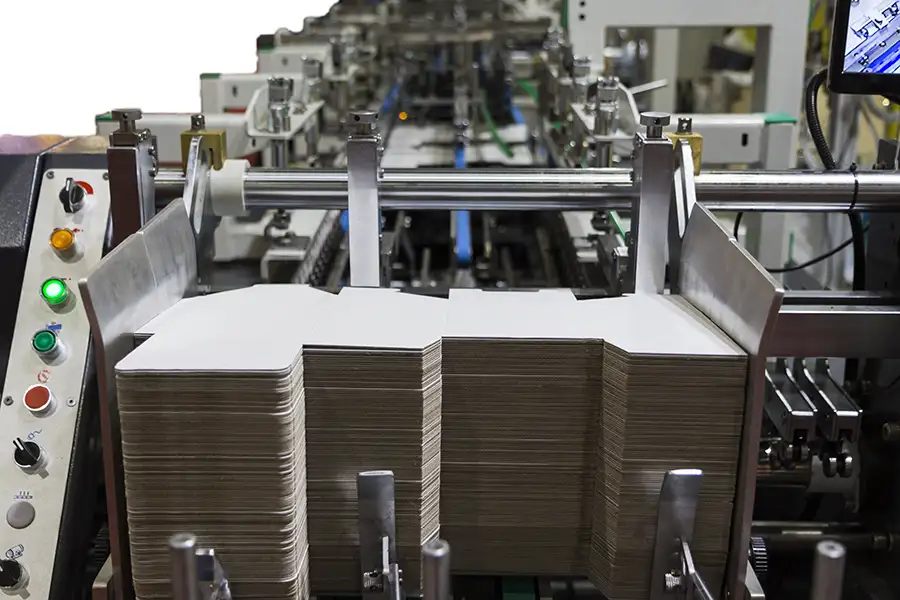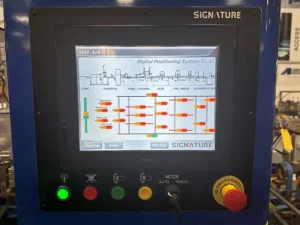
Compiled by Erin La Row, editor, PostPress
The automated folding/gluing process helps producers save time and money transforming flat, printed items into cartons and boxes. But as labor challenges continue across industries, finding skilled folding/gluing operators is tough for many companies.
PostPress talked with Kevin Koplin, director of operations with American International Machinery, Inc. (AIM)/Signature Folder Gluers, and Rick Pallante, president, Baumer hhs USA and Canada, about overcoming the challenges in today’s folding/gluing environment.
What recommended technologies, training and/or ancillary equipment can a company use with its folder-gluers to help decrease the learning curve and run folder-gluers more efficiently?
Koplin: The best way to economically find good gluer operators is to train them. Memory retention is one of the biggest challenges in today’s world. Use photos and videos. Select the most common and challenging jobs to create an in-house video. Supplement this with documentation, including pictures that mirror the videos that are produced. These will be enormously helpful to trainees and current operators.
Computerized makeready systems, both automatic and semi-automatic, can be a great addition to the standardization of the makeready process. An automatic makeready system allows operators to load the measurements of a job into the machine software where it will save the job. The software then calculates the measurements and moves its carriers to the measured location. Settings will be stored under the file name that is given to it. Operators can save their settings and then make minor adjustments with the push of a button. Subsequently, the file will be up to date for future runs. Semi-automatic makeready systems are similar to automatic ones, minus automation. Some systems allow the operator to set up the product and then save the product to the database. When the product is put on the machine again, the operator recalls the job to the screen and the computer loads the specifications. The information is sent to the machine’s dial indicators and then the operator moves the components to the stored location one at a time. The makeready still is done manually, but the machine is giving the operator the locations.

Pallante: Folder-gluer operators are becoming a limited resource. The level of expertise of a folder-gluer operator has changed as well. Technicians are spending more time assisting operators with training for setting up the folder-gluer itself, in addition to their normal duties of installing the training on the gluing system. Machinery is becoming more complex as it is being asked to do many more things than it did in the past. Training is the most important thing an equipment company can provide. It’s done in-person at installation, but it has to be something that also is invested in after installation. Operator interfaces have changed so that they are more intuitive and less complex, even though they provide more capabilities than in the past. Many systems carry instructions in the Help section on the monitors. The more information operators can access easily and simply, the more it will help them in their responsibilities.
Finishers and folding carton manufacturers must run efficiently and have as little waste as possible to stay competitive and maintain margins. What are recommendations for a folder-gluer to help decrease waste and increase productivity?
Koplin: Sometimes it is impossible to avoid waste, but here are a few ways to keep it to a minimum. Setting up multiple jam switches in sensitive areas will avoid excessive product waste and decrease downtime and spoilage. Stopping the machine with the defective product will minimize damage to the cartons and the machine. Thus, operators will decrease downtime. Also, consider an inline carton ejector to remove bad products from the machine while it continues to run. This also takes the human factor out of the equation, meaning it ensures the waste will not be missed or packed in a case. Finally, preventative maintenance is very important. A properly functioning gluer that makes sure everything moves and works correctly is key to a strong successful setup. A preventative maintenance program to maintain the gluer is very important!
Pallante: Companies are is measuring their own key performance indicators and overall equipment effectiveness. Both of these can be dependent on having the system run as long as possible with the fewest stops and lowest amount of production waste. Quality control (QC) systems – whether moisture-based, UV- tracer-sensitive or camera-based – indicate to the operator how accurately the glue is being placed on the carton. With adhesive dispensing applicators that are reliable and repeatable, the tolerance on the glue pattern can be kept constant. If the pattern begins to move, there can be several factors that are causing this that can be addressed. These can be machine-related, such as a belt slipping or a worn encoder, or glue-related, such as a different glue or viscosity being introduced, or a change in the carton diecut. The determination between a good and a bad carton is measured in millimeters and milliseconds. The sooner it can be recognized, the sooner it can be corrected. Sometimes, operators will try and turn off the QC system rather than look for the cause. Most systems now have fail-safes that prevent that from happening, which will ensure quality produced cartons arrive at the customer.
What new challenges have been seen in recent months with customers that have folding/gluing operations (paper stocks, printing inks, glues, etc.)? And what recommendations can be made for these challenges?
Koplin: The biggest challenge is the lack of personnel. This last generation of retirees is not replaceable – we have to build operators. This is why automation is so critical. The labor pool simply isn’t there. Fluctuations are seen in substrates. Paper mills look for cost reductions on their end, and more additives are found in the boards. And special applications such as security tags, labels, tape, inserts and imprinting, cause challenges. For these reasons, AIM/Signature had additional lengths added to the gluer to support any future ancillary equipment.
Supply chain challenges continue to be an issue with unpredictable lead times and material shortages worldwide. Standard items, such as electronics, paper, belts, etc., that were once a few days out now are taking weeks or longer. Unfortunately, this is out of manufacturers’ control, so being proactive and having extra parts on hand before the machine goes down is one recommendation.
Pallante: Thankfully, these are becoming less as the supply chain starts to catch up to demand. Customers were trying to run different adhesives due to availability. This can start a glue pattern late or increase tailing at the end of the pattern. Having the best dispensing technology with a strong, robust coil and fast closing can better manage these changing viscosities. On the carton front, more cartons are being made from recycled content. This content typically contains UV from printing, as well as UV tracers used in the adhesives. QC systems that are dependent on UV tracers for glue detection can become “blind” as they can no longer detect the difference between the UV tracers in the glue and the UV now in the carton fibers. Customers are having to move to moisture- or camera-based technologies to combat this situation.
Run lengths for folding cartons and other products continue to decrease. What type of ancillary or other equipment accessories should a folder-gluer have to help with quick set-up and makeready?
Koplin: Once again, computerized makeready systems truly make set-ups go faster, thus allowing for more makereadies in less time.
Having enough tooling to make fixtures, such as lock-bottom assemblies that can be mounted to the machine instead of having to put individual parts together each time, cuts down on time considerably. There should be no reason that all parts are taken apart each time and reassembled for the following job. With additional tooling, operators also can put together special components while another job is running. Pre-manufactured parts, such as Z-Fold attachments, are available to eliminate having to do any assembly.
Pallante: From the gluing side, operators want to be able to easily access a program from the controller that saves the information so if a job is run again, the parameters can be pulled up easily and quickly. They also can do a “copy and paste” using one program to quickly create another. For the applicator, having an applicator that closes securely matters. Operators need to be able to leave it for an extended period of time and not have to worry about covering the nozzle tip every time. They need to be able to start the system up and glue that first carton. A quality applicator will provide that.
What new technologies are on the horizon that will help with the efficiency and productivity of folder-gluer equipment and/or ancillary equipment?
Koplin: Adding detection (glue, doubles, window, bar code, etc.) works well to remove waste from the machine without disrupting production. Detection also takes the human factor out of having to sort through cartons prior to packing to find bad products, which then allows them to pack more efficiently and accurately. Print detection also is becoming more common and is required by some customers, especially pharmaceuticals. Print inspection – both words and color – guarantees the wrong product or misprinted product will not be sent through the machine. This also can be tied to the inline ejector to remove prior to packing.
Pallante: Artificial intelligence (AI) is going to change things, maybe not as quickly as end users would hope, but I think it will come into play with preventive maintenance calculations. Being able to gather the data and allow it to be manipulated by customers for use by their systems will be the next big thing for this industry. Getting the data will be a challenge. It’s going to be more than counting strokes. It’s going to be asking how this stroke compared to the last stroke. Is there a trend? Can it be changed internally, or should the operator be notified that maintenance is imminent? It’s going to be very interesting to see what lies just over the horizon.
PostPress magazine would like to thank Kevin Koplin, director of operations with American International Machinery, Inc. (AIM)/Signature Folder Gluers –
www.signaturefoldergluers.com and Rick Pallante, president, Baumer hhs USA and Canada – www.baumerhhs.com for their assistance with this article.

